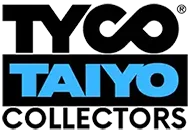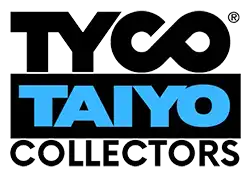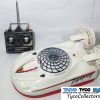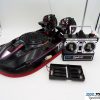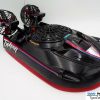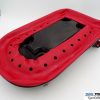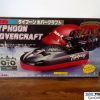The Taiyo Typhoon Hovercraft was the first consumer radio control hovercraft, initially sold by Taiyo in Japan in 1988 before finding worldwide popularity across Europe, Australia, and the United States under localized brands such as Tyco RC, Dickie Toys, Metro RC, etc.

Features and Performance
All Typhoon class vehicles were fitted with three motors, with the largest ones being the 2x Mabuchi RK370 motors driving the rear fans. These were powerful enough to push the Typhoon very quickly up to 15km/h (9mph) on smooth flat surfaces, however the problem was never power...
Typically the biggest control difficulty with the Typhoon was the simple fact that it was'nt directly anchored to the ground with wheels and tires like a regular vehicle. This makes slowing down and especially corning very challenging - you are literally floating upon air, making sharp turns and brakes a mere suggestion to the vehicle, rather than a command!
As a full size model, this Typhoon had a red button on the top right of the controller which controlled whether the central fan was on or off. Switching it off while the vehicle was moving is kind of like a handbrake, though I don't know how effective that would really be. Mini Typhoon models would remove this and instead have the fan on constantly.


Acclaim
Following Taiyo's immense success with the Jet Hopper in 1986, the Typhoon was the only product since then which had come close to the Jet Hopper's sales, and it soon became the flagship product for the year, winning the Tokyo Governor's Award at the 1989 Toy Show, and finding success globally as the Tyco Typhoon in the USA, and under various other brands worldwide.
To mark the award, in 1989 a golden sticker was placed on each box sold at the time, as shown below.

Do you have one 'Made in Japan'?
Both the Global and Japanese market models were Made in Singapore, which is unusual for Taiyo, who would always manufacture Japanese market variants Made in Japan.
There are "Made in Japan" versions out there, they're just less common than the more widely seen Made in Singapore versions.


Further models
As expected, Taiyo took advantage of its popularity and over the next decade launched many spin-offs:
Do alkaline batteries damage the Typhoon?
During our research, we came across some European model Typhoons with a sticker on the front "Use only Ni-Cd batteries". Nickel-cadmium AA batteries are 1.2v rechargeable, and so 8xAA = 9.6V. However it's always been common for people to use regular 1.5v non-rechargeable batteries, which gives us 8xAA = 12V. Turbo Power!
So does the Typhoon have an issue with this? Maybe. It's the only model that has its motor constantly running at the highest speed (the central 'compressor' fan), so its possible this becomes overheated and the brushes on the motor wear faster than usual, and no more hovercraft.
There's extra credence to this theory when you consider that Taiyo and Tyco introduced heat sinks to all their high powered 9.6V models, to reduce wear created by constant high speed running.
Recommendation
If you've got this far, then I'm pretty sure you're likely to want a Typhoon no matter what. They're often one of the first buys for collectors due to their popularity in the late 80s, even with the troublesome controls there's still much love for these ice-skating gimmicks, and the various successor models.
Obviously when buying, the #1 most important aspect to consider is the condition of the air skirts which often develop holes and tears. It's possible to purchase replacements (new old parts from Taiyo / Tyco) however they're extermely rare so it's not something that can be counted on.
Apart from that, check the rear fans to ensure they're not damaged, and if all is well you're good to purchase.
